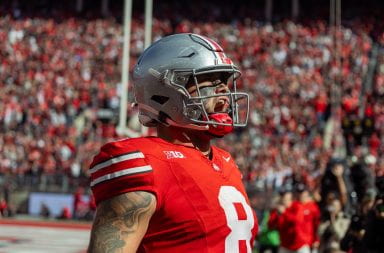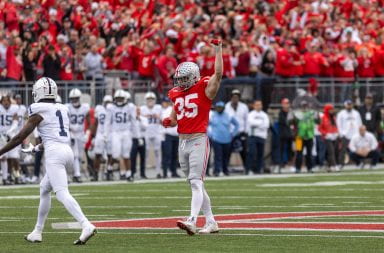
Credit: Abby Fricke | Managing Editor For Design
Before reaching for that extra boost of energy, dietitians recommend students consider the “monster” hidden within seemingly innocuous cans of energy drinks: too much caffeine.
Though students can expect to feel less fatigued after consuming one of the drinks, Liz Weinandy — an instructor of practice in dietetics and nutrition at Ohio State’s School of Health and Rehabilitation Sciences — said energy-seekers should first contemplate the perils of excessive caffeine consumption. These include heart failure, increased anxiety, high blood pressure, jitters and, in the worst cases, even death.
Though the impacts of caffeine intake vary from person to person due to weight and other sensitivity considerations, Weinandy said the FDA’s recommendation for daily caffeine intake is 400 milligrams. This equates to roughly four or five cups of coffee, half of which can be found in just one energy drink.
“There’s almost no regulation from the government over [energy drinks], other than if there’s an adverse effect or something happens. Then, the FDA can send a warning to companies,” Weinandy said. “Outside of that, they’re really poorly regulated and controlled.”
Weinandy said energy drinks often contain high levels of sugar, another nutritional concern linked to weight gain and diabetes. Still, she said the main issue now lies in the drinks’ elevated caffeine content, particularly with the emergence of zero-sugar alternatives.
Though the FDA mandates that carbonated sodas containing synthetic caffeine — a higher concentration of caffeine produced in a lab rather than naturally extracted from plant products — list caffeine among their ingredients, Weinandy said they are not obligated to specify the quantity.
“[Energy drinks] should be mandated to put the amount of caffeine or any other ingredients that might be considered stimulants on the label,” Weinandy said.
Ciara Bartholomew, a graduate student in dietetics and nutrition, said the immediate effects of excessive caffeine intake primarily involve neurological repercussions, such as the disruption of sleep. On the other hand, she said prolonged intake can impact cardiovascular health by potentially increasing heart palpitations and high blood pressure.
“[Energy drinks] tend to have a lot of vitamins added into them, and to be honest, I think it’s just there to look pretty,” Bartholomew said. “It’s not really something that’s going to be terribly beneficial, especially if you already have a good, well-balanced diet.”
Bartholomew said two vitamins emphasized by energy drinks’ labels, despite the little nutritional value they realistically offer, are vitamin B3 and vitamin B6.
The first is a compound known to help treat high cholesterol and is naturally abundant in beef and fish. The latter is essential for brain development and immune function but can be obtained from fruits and vegetables like bananas or dark leafy greens.
“B-vitamins are not something that we store in our body,” Bartholomew said. “If we have more than enough, we tend to excrete it in urine anyway, so it’s mostly the sugar and caffeine content we need to be worried about.”
When combined, excessive caffeine and sugar intake can cause cirrhosis, a condition that can leave one’s liver scarred or permanently damaged, Weinandy said, similar to the effects of heavy alcohol consumption.
“I would also be remiss if I didn’t talk about mixing these drinks with alcohol,” Weinandy said. “We’ve seen students in the emergency department who have taken in a lot of caffeine, nullifying the depressant effects of alcohol, so it’s a dangerous combination when they start mixing caffeine with other ingredients.”
Popular energy drink brands among students include Bang, boasting 300 milligrams of caffeine per can, Celsius, with 200 milligrams per can and Monster Energy, containing 160 milligrams per can. Weinandy said after consumption exceeds more than one drink a day, concern grows dramatically.
“Once you get up around 200 milligrams or more, those are the ones I would really pay attention to,” Weinandy said. “What scares me is that it is the marketing technique for a lot of these drinks. [Companies] make them fruity, and they’ll make the packaging really bright, and in my mind, it’s analogous to vaping all of those flavors.”
Grant Donnelly, an assistant professor of marketing and logistics at Ohio State, said the branding employed by energy drink companies frequently targets college students. This contributed to a noticeable uptick in consumption over the last eight years.
“The general trend from what I’ve looked at from college campuses is that the energy drink consumption is exploding,” Donnelly said. “Energy drinks seem to be the stated special unicorn that is incredibly sugary, but people don’t perceive it to be unhealthy.”
Companies like Red Bull have strategically developed the names, imagery and slogans of their drinks to appeal to younger consumers, Donnelly said. Their advertisements often highlight the notion that energy drinks enhance productivity over addressing potential health concerns, like “Red Bull gives you wiiings.”
After examining trends, Donnelly said there has been a shift in energy drink consumption from peaking during exams to consistently high levels throughout the year.
“My hunch is that early adoption was that [consumption] would need to be justified, and now, it no longer needs to be justified,” Donnelly said. “It’s just a normative behavior that people do.”
Donnelly said young college students are ideal targets for companies aiming to cultivate lifelong customers, an idea supported by extensive partnerships energy drink brands forge with universities.
In 2018, Ohio State entered a 15-year pouring rights contract with Coca-Cola — an agreement that grants the company the right to sell and market certain beverages across campus and has a projected value of almost $85 million — according to a September 2018 article from Ohio State News. The company partially owns Monster Energy drinks, which are available for purchase via several vending machines around campus.
“It has sort of made, unfortunately, students kind of susceptible to a lot of marketing communication because the universities are like customers in a way,” Donnelly said. “Much like we banned cigarette smoking on campus, I think we should do the same for sugary beverages because they have negative health impacts for people.”
Ria Akhilesh, a second-year in finance, said she has sometimes consumed as much as two to three energy drinks a day when faced with the impending academic pressures of exam weeks and personal tasks.
“I definitely have at least a few a week, so I am a regular consumer,” Akhilesh said. “I just think the functionality of an energy drink sometimes cancels the attached health risks out, but I know that’s not always right. It’s just what I say to myself so I feel better about it.”
As a student, Akhilesh has seen a growing prevalence of energy drink culture among friends and peers for various reasons, including escalating workloads, habitual consumption and the influence of targeted advertisements.
“[Energy drinks] are being marketed as a lifestyle instead of just one single drink,” Akhilesh said. “It’s part of a healthy life image, but there are also health risks the branding kind of mitigates completely.”
Despite experiencing energy drinks’ adverse health effects, such as jitters, Akhilesh said she still consumes them as part of her daily routine. Recently, however, she started moderating her intake more strictly after becoming informed of the potential health risks associated with caffeine consumption.
Alternatively, Weinandy said she recommends students consume coffee or tea in moderation to satisfy their everyday cravings for caffeine. Still, this change must be balanced with getting good sleep, maintaining a balanced diet and slowly eliminating dependence on energy drinks.
“[Coffee] can actually improve a person’s overall nutritional status,” Weinandy said. “Energy drinks are really not going to have anything in them beneficial other than just being fluid.”
Initiating education about the impacts of excessive caffeine consumption at a young age should be the first step in curbing the proliferation of energy drink culture among young adults, Bartholomew said.
“Kids only get about eight hours worth of nutrition education per school year when they really should get about 40 to 50 hours to elicit behavior change,” Bartholomew said. “I can guarantee you they’re probably not learning anything about energy drinks.”


